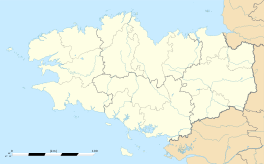Locmariaquer
|
Locmariaquer Lokmaria-Kaer |
||
|---|---|---|

General view of the harbour
|
||
|
||
| Coordinates: 47°34′12″N 2°56′39″W / 47.57°N 2.9442°WCoordinates: 47°34′12″N 2°56′39″W / 47.57°N 2.9442°W | ||
| Country | France | |
| Region | Brittany | |
| Department | Morbihan | |
| Arrondissement | Lorient | |
| Canton | Auray | |
| Intercommunality | Trois Rivières | |
| Government | ||
| • Mayor (2008–2014) | Michel Jeannot | |
| Area1 | 10.99 km2 (4.24 sq mi) | |
| Population (1999)2 | 1,367 | |
| • Density | 120/km2 (320/sq mi) | |
| Time zone | CET (UTC+1) | |
| • Summer (DST) | CEST (UTC+2) | |
| INSEE/Postal code | 56116 / 56740 | |
| Elevation | 0–19 m (0–62 ft) (avg. 16 m or 52 ft) |
|
|
1 French Land Register data, which excludes lakes, ponds, glaciers > 1 km² (0.386 sq mi or 247 acres) and river estuaries. 2Population without double counting: residents of multiple communes (e.g., students and military personnel) only counted once. |
||
1 French Land Register data, which excludes lakes, ponds, glaciers > 1 km² (0.386 sq mi or 247 acres) and river estuaries.
Locmariaquer (Breton: Lokmaria-Kaer) is a commune in the Morbihan department in Brittany in north-western France.
It lies 8.5 mi (13.7 km) south of Auray by road.
This coat of arms was created 30 years ago by the local artist Jean-Baptiste Corlobé. The arms portray:
All are surmounted by a baronial crown (Locmariaquer was part of the former barony of Kaër). It bears the Breton language motto: "Kaër e mem bro" which can be interpreted in two ways: "Kaër is my country" or "my country is beautiful" (the phrase originated with JM François Jacob in 1933).
From the Breton loc which means hermitage (cf.: Locminé), Maria and kaer which means nice or more likely from the Old Breton caer (Modern Breton, ) which means fortified place,city.
The municipality of Locmariaquer is located at the western tip of the Gulf of Morbihan in Brittany and has many beaches facing the Atlantic Ocean and the bay Quiberon.
This small town contains the Locmariaquer megaliths, some of the most significant neolithic remains in Europe, including the Broken Menhir of Er Grah, the largest known single block of stone to have been transported and erected by Neolithic man. It is beside the Table des Marchands, a famous dolmen with notable carvings.
In the nineteenth century it became the home of the popular Catholic writer Zénaïde Fleuriot, who idealised it in her novels.
...
Wikipedia



